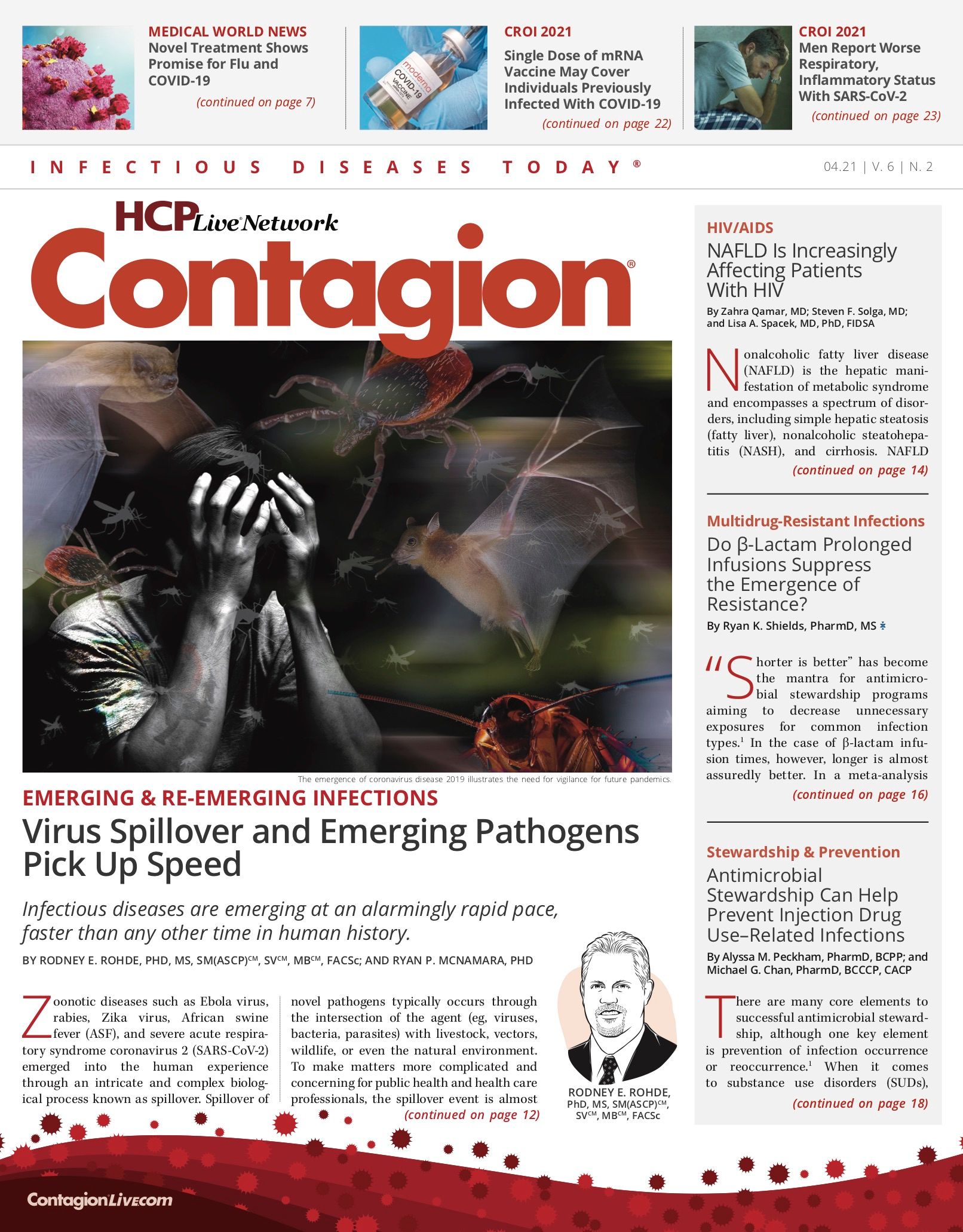Molecular Diagnostics for Bacterial Pneumonia Need Testing Stewardship
Ongoing education and proven outcomes need to aid this form of testing.

Respiratory tract infections remain a frequent cause of antimicrobial use in the hospital setting.1 The Centers for Disease Control and Prevention (CDC) noted in its report 2017: Antibiotic Use in the United States that there are 47 million unnecessary antibiotic prescriptions written each year by US providers, and most of these are for respiratory tract infections, including suspected pneumonia.2 The CDC estimated that at least 50% of antibiotic prescriptions for acute respiratory conditions were unnecessary.2
From the commonly used respiratory viral panel to the current SARS-CoV-2 polymerase chain reaction (PCR) testing, molecular diagnostic tests for the identification of frequent pathogens causing pneumonia have gained considerable attention. Early identification of pathogens in respiratory viral infections can lead to improved antimicrobial stewardship efforts to ensure that pathogens are appropriately treated, antibiotics are narrowed as appropriate, and better outcomes achieved.3
The PCR-based respiratory viral panel is frequently used to diagnose pneumonia. However, using molecular detection techniques for bacterial pathogens is not as widespread. Similar to blood or sputum cultures, selective use of these techniques may lead to more targeted antimicrobial therapy to ensure that target pathogens are being treated while using as narrow a spectrum of antibiotic as possible.
However, in facilities where bacterial pneumonia molecular diagnostics are not available, there are other methods that can be used for nosocomial pneumonia, such as the methicillin-resistant Staphylococcus aureus (MRSA) nasal screen and standard sputum culture. The MRSA nasal screen has been shown to correlate with the need for ongoing anti-MRSA therapy for nosocomial or ventilator-associated pneumonia (VAP) and is readily available.4,5 Despite this availability, however, there often is still prolonged vancomycin use in patients with VAP.6 If an already-available method is not being frequently used, is there a reason to think that more advanced techniques will lead to appropriate narrowing of the antimicrobial spectrum in patients with pneumonia?
Another consideration is cost. Standard, commercially available molecular diagnostics panels for respiratory viral pathogens can carry significant expense (up to $170 per test, according to 1 estimate).7
Utility of molecular diagnostic tests also depends upon the clinical setting. For example, in the outpatient setup, it is not likely that PCR-based bacterial pneumonia panels will be frequently indicated, given the minimal overall severity of most patients and logistical issues with testing in these settings. Meanwhile, these tests can be a game changer in an inpatient setting, particularly in intensive care units where early selection of appropriate antibacterial therapies can save lives. Similarly, in the emergency department setting, such testing may more likely be technically possible because of the hospital-based laboratory facilities. Patients may be selected based upon risk factors and severity of illness to determine the need for PCR-based testing, and the quick test result may help in deciding triage and level of care. Molecular diagnostics for bacterial pneumonia, in the appropriate setting, may lead to improved antibiotic use and patient outcomes. However, testing alone will not accomplish this. There needs to be a combination of testing the appropriate patients and using the results to adjust antibiotic regimens accordingly.
This leads to diagnostic testing stewardship. The concept is based on choosing a diagnostic test wisely, based on pretest probability in a relevant clinical scenario. Although it may be easy to order molecular testing on all patients with community-acquired pneumonia (CAP), it is unlikely that overall treatment will change in patients with a straightforward presentation, such as an aspiration event. However, testing would be much more likely to change outcomes in patients with VAP or nosocomial pneumonia, given the wide spectrum of pathogens that may be in play. As these patients tend to receive the broadest spectrum antibiotics for the longest duration, appropriate diagnostic stewardship may optimize their clinical outcomes. It may be reasonable to limit molecular testing of pneumonia to patients who are not improving, have a history of resistant organisms, or have nosocomial or ventilator-associated infections. It is important to highlight that the 2019 American Thoracic Society/Infectious Diseases Society of America CAP guidelines recommend obtaining sputum culture in patients with severe pulmonary disease as well as in all admitted patients being empirically treated for MRSA or Pseudomonas aeruginosa.8
Unfortunately, there is often a delay in obtaining sputum samples for culture until after antibiotics have been taken which decreases the yield of this testing. In cases such as this, molecular diagnostic techniques may be beneficial, allowing detection of pathogens that will no longer grow in culture due to previous antibiotic exposure.
As antimicrobial stewardship-service is now required for all hospital settings per the Centers for Medicare & Medicaid Services and The Joint Commission, evaluating both conventional culture and molecular testing results and communicating with the bedside providers can be part of the standard practice. In a retrospective review, Weiss et al elaborated that utilization of the multiplex respiratory panel with a clinically actionable turnaround time was associated with reduced hospital admissions and lesser antibiotic initiation in patients without abnormal radiographic findings.9 It is reasonable to expect that collaboration between the bedside providers and antimicrobial stewardship teams will lead to better patient outcomes and should decrease both overall expense and unnecessary diagnostic testing.
As there was initially much objection when certain antibiotic restrictions were first instituted, there may be similar objections to the restriction of certain diagnostic testing. Ongoing educational efforts and demonstrably better outcomes, however, will likely lead to acceptance over time. It is strongly recommended that institutions begin the process of establishing guidelines for the use of novel molecular diagnostic tests for bacterial pathogens (diagnostic stewardship), expand the influence of antimicrobial stewardship teams, and thus optimize patient care and clinical outcomes.
Faran Ahmad, MBBS, FACP, is a clinical fellow of infectious diseases at Creighton University School of Medicine in Omaha, Nebraska.
Renuga Vivekanandan, MD, is an associate professor and an assistant dean at Creighton University School of Medicine in Omaha, Nebraska. She also is chief of Division of Infectious Diseases at Creighton University School of Medicine-CHI Health and director of CHI Health Nebraska/Iowa Regional Antimicrobial Stewardship Program.
David Quimby, MD, is an assistant professor of infectious diseases at Creighton University School of Medicine in Omaha, Nebraska, and medical director of infection prevention at CHI Health’s Midwest Division.
References
- Gonzales R, Malone DC, Maselli JH, Sande MA. Excessive antibiotic use for acute respiratory infections in the United States. Clin Infect Dis. 2001;33(6):757-762. doi:10.1086/322627
- Fleming-Dutra KE, Hersh AL, Shapiro DJ, et al. Prevalence of inappropriate antibiotic prescriptions among US ambulatory care visits, 2010-2011. JAMA. 2016;315(17):1864-1873.
- Kuypers J. Impact of rapid molecular detection of respiratory viruses on clinical outcomes and patient management. J Clin Microbiol. 2019;57(4):e01890-18. doi:10.1128/JCM.01890-18
- Dangerfield B, Chung A, Webb B, Seville MT. Predictive value of methicillin-resistant Staphylococcus aureus (MRSA) nasal swab PCR assay for MRSA pneumonia. Antimicrob Agents Chemother. 2014;58(2):859-864. doi:10.1128/AAC.01805-13
- Parente DM, Cunha CB, Mylonakis E, Timbrook TT. The clinical utility of methicillin-resistant Staphylococcus aureus (MRSA) nasal screening to rule out MRSA pneumonia: a diagnostic meta-analysis with antimicrobial stewardship implications. Clin Infect Dis. 2018;67(1):1-7. doi:10.1093/cid/ciy024
- Peyrani P, Wiemken TL, Kelley R, et al. Higher clinical success in patients with ventilator-associated pneumonia due to methicillin-resistant Staphylococcus aureus treated with linezolid compared with vancomycin: results from the IMPACT-HAP study. Crit Care. 2014;18(3):R118. doi:10.1186/cc13914
- Lin B, Christian, M, Kogan M, Zuretti A. Choosing the right test (influenza) versus respiratory viral panel with faster turnaround time and cost savings. Am J Clin Pathol. 2019;152(suppl 1):S142–S143. doi:10.1093/ajcp/aqz130.002
- Metlay JP, Waterer GW, Long AC, et al. Diagnosis and treatment of adults with community-acquired pneumonia. An official clinical practice guideline of the American Thoracic Society and Infectious Diseases Society of America. Am J Respir Crit Care Med. 2019;200(7):e45-e67. doi:10.1164/rccm.201908-1581
- Weiss ZF, Cunha CB, Chambers AB, et al. Opportunities revealed for antimicrobial stewardship and clinical practice with implementation of a rapid respiratory multiplex assay. J Clin Microbiol. 2019;57(10):e00861-19. doi:10.1128/JCM.00861-19

